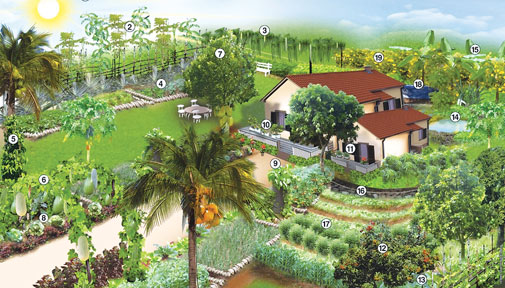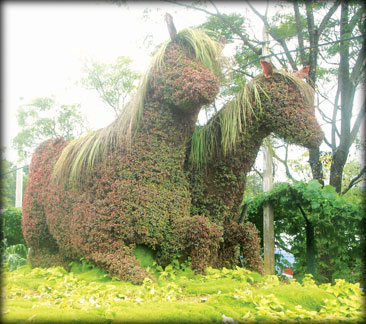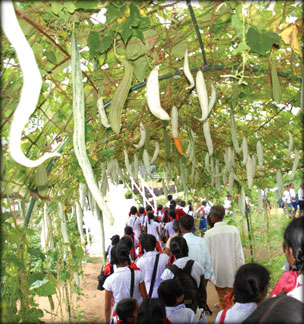|
Edible landscaping:
Revolutionary concept in home-gardening
By Ganga Ratnayake
In the past, home-gardens were used to beautify the environment
around the house, by growing ornamental plants bearing vivid flowers and
foliage. Conversely, food crops such as vegetables, fruits and herbs
were usually grown in a corner of the backyard or in a field some
distance away.
 |
|
Dr. Rohan Wijekoon |
|

An illustration of a landscape for home-gardens |
However, as time passed, the exotic flora in the gardens were
replaced by their not-so-stunning counterparts. These food crops soon
left their lacklustre formations behind and sprawled across the terrain,
creating wonderful designs and patterns.
The concept has now reached all corners of the world, and has even
resulted in a unique appellation as ‘edible landscaping’. An edible
landscape usually combines ornamental plants with vegetables, herbs,
root crops and fruit and nut trees and present them in captivating
designs. In fact, this concept can be traced back as far as the gardens
of ancient Persians and Medieval monasteries as well as the 19th century
courtyards of English suburbs.
To learn more about edible landscaping and its benefits, I met the
very person who played a major role in adapting and introducing this
concept to Sri Lanka, Dr. Rohan Wijekoon, Director Information and
Communication Centre at the Department of Agriculture, Peradeniya.
Localised edible landscaping was first introduced through the
Gannoruwa Agro Technology Park in 2004. Like other types of flora, food
crops are also classified as annuals and perennials. Annuals are crops
with a life cycle that lasts for one year, and comprise vegetables and
root crops. Conversely, perennials are crops with a life cycle that
lasts three or more years and include fruit trees and palms.
Phytonutrients and different colours
As per the latest global discoveries, the Department of Agriculture
(DOA) encourages people to grow not only green-hued plants, but also
plants containing the five miraculous colours to obtain the best of
phytonutrients. The term ‘phytonutrient’ describes natural chemicals
found in plant food that helps us to prevent or fight diseases and
chronic health issues such as cancer, hypertension, diabetes and
cardiovascular diseases.
 |
|
Edible landscaped
horses |
The good news is that you can obtain phytonutrients from your home
garden simply by growing vegetables and fruits bearing the five
miraculous colours - white, blue (purple), green, yellow (orange) and
red. In fact, fruits and veggies in deep red tones are high in
antioxidants with the potential to fight cancer head on.
Self-sufficiency
When producing an edible landscape, as per the illustration on right,
it is important to identify the main directions of your landscape. Avoid
planting big perennial trees on the east and plant only small trees with
sparse foliage like humming bird trees (katuru murunga) and drumstick
trees (murunga). This prevents big trees from shadowing the small
growing plants that need plenty of sunlight for at least six hours a
day.
An edible fence can be built on the east by entwining a typical fence
with vines such as passion fruit, followed by a row of spiky pineapples
flanking the fence. The latter is ideal to keep small animals from
sneaking in and destroying the crops. Build a trellis facing the east to
grow a potpourri of vines including bitter gourd (karawila), luffa
(wetakolu), snake gourd (pathola), Chinese long bean (ma karal), winged
bean (dambala), bottle gourd (labu) and ash gourd (puhul).
Next, replace the conventional flower beds with any type of
vegetable, but remember not to plant crops of the same family as a means
of naturally controlling pests. These vegetable beds can take any shape,
from circular, semi-circular to even intricate traditional designs.
These beds can provide a cosy home to tomatoes, beans, onions, carrots
or lady’s fingers.
At the north, grow tall palm trees and fruit trees, and make coconut
trees the ideal support for climbing pepper. The base of coconut trees,
within a six-foot diameter, is ideal for growing various kinds of
vegetables. To adorn the entrance of your garden, put up an arched
trellis and wrap it with vines such as winged bean and bottle gourd.
If you like to provide some shade to your house, plant perennial
fruit trees close by and to the east of the house.
Rocky terrain
If the terrain happens to be rocky, fill in crevices and cavities
with ample soil and grow colourful edible plants to make a fine rock
garden. Add a summer hut with an edible canopy and you can even enjoy
your meals outdoor in a breezy spot. The same goes for uniform hedges,
which can be replaced with colourful vegetables such as cabbage, beet,
salad and spinach. While the common spinach is a green plant, its ruddy
counterpart - Malabar spinach - is a climbing plant which can be
transformed into various shapes three dimensionally.
 |
|
Edible canopy |
The DOA offers a variety of ideas to create a breathtaking edible
garden, and some of the features include potted fruit trees, leafy
vegetable pond and banana fence. Use the hydroponics technique (growing
plants in a nutrient solution instead of soil) with discarded rigifoam
or styrofoam boxes instead of costly pots, and you are ready for
recycling.
To manage rainwater and prevent soil erosion, terraces and the
Indonesian Sorjan system can be adapted. Sorjan turns the land into
alternative ridges and furrows, each as wide as five feet. Vegetables
can be planted across the ridge while aquatic or marshy edible plants
such as lotus, yellow sawah lettuce (diya gowa) and giant taro
(habarala) can be tucked in water-filled furrows..
DOA accomplishments
The concept and knowledge of edible landscaping is constantly
disseminated by the DOA since 2004 through the Gannoruwa Agro Technology
Park and its Audio Visual Centre. In addition, through the Deyata Kirula
exhibitions, the DOA not only promotes this innovation-filled concept to
a wider audience, it also bagged first place at the exhibition for seven
years consecutively.
Moreover, as recognition of the contribution made for agriculture and
environment by promoting edible landscaping and agricultural know-how
through agro parks, exhibitions and mass media, Dr. Wijekoon received
the National Achiever’s Award 2013 at the 8th Annual District Convention
of the Lion’s Club International on May 18 at the BMICH, Colombo.
All in all, edible landscaping is a fun pastime to combine ones’
imagination and creativity with gardening skills. These landscapes not
only add charm and colour to your garden, but also save money and
provide fresh, healthy food everyday.
Fill a basket with a variety of fresh veggies, herbs and fruits
picked right off your garden and you can add a wide assortment of
delectable dishes, snacks, juices, smoothies and salads to your diet.
And if you make edible gardening your pastime, you’re bound to gain a
daily workout and live longer, wiser, healthier and happier. |


